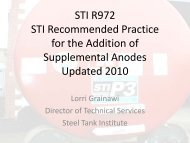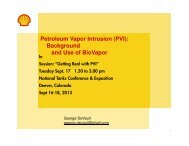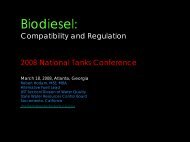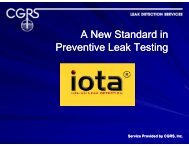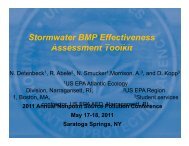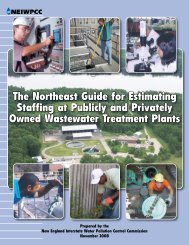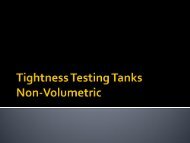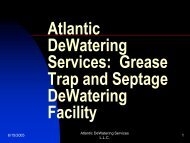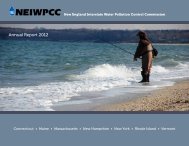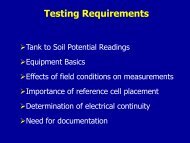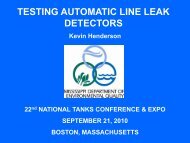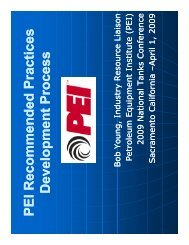Wardle Challenges Weds.pdf - NEIWPCC
Wardle Challenges Weds.pdf - NEIWPCC
Wardle Challenges Weds.pdf - NEIWPCC
Create successful ePaper yourself
Turn your PDF publications into a flip-book with our unique Google optimized e-Paper software.
Predicting petroleum<br />
movement in fractured bedrock<br />
Alex <strong>Wardle</strong><br />
Petroleum Program, Northern Regional Office,<br />
Department of Environmental Quality, Commonwealth of<br />
Virginia<br />
National Tank Conference,<br />
Sacramento, California, April 2009
The problem<br />
• “Groundwater flow<br />
conditions in the fractured<br />
bedrock media in the area<br />
of the site are generally<br />
undefinable.”<br />
• “… the existing<br />
groundwater<br />
contamination onsite<br />
could, with little or no<br />
reduction in concentration,<br />
impact nearby water wells<br />
and environmental<br />
receptors”<br />
A. Consultant, 2000(-2007)
Summary<br />
• Bedrock contaminant movement – too far, too<br />
fast, erratic and in the wrong direction?<br />
• Is contaminant movement in bedrock<br />
predictable?<br />
• “Sand box” investigation techniques confuse,<br />
prolong and may even “create” cases when<br />
used in bedrock<br />
• If not the long screen well, how to investigate?<br />
• Case studies showing how understanding the<br />
fracture system helps resolve cases
Outline<br />
• Review of contaminated drinking water<br />
well cases<br />
• Basic principles<br />
• Case studies showing<br />
– Speed and directionality of bedrock<br />
contaminant flow<br />
– Investigation techniques
Petroleum releases and polluted<br />
wells
Well review<br />
• Geologic province and structural dip<br />
direction<br />
• Type of petroleum (non regulated<br />
heating oil or regulated gasoline)<br />
• Age of well<br />
• Distance from release<br />
• Direction from release to well<br />
• Concentration of MTBE or benzene<br />
in well<br />
• Wells included in the survey were<br />
those assessed, treated or replaced<br />
under DEQ’s alternative water<br />
supply program<br />
N<br />
Bearing<br />
Distance
30%<br />
25%<br />
20%<br />
15%<br />
10%<br />
Wells and Distance<br />
5%<br />
0%<br />
Piedmont and Blue Ridge: distance between<br />
release and impacted well<br />
0 to 50<br />
51 to 100<br />
101 to 150<br />
151 to 200<br />
201 to 250<br />
251 to 300<br />
301 to 350<br />
351 to 400<br />
401 to 450<br />
451 to 500<br />
Distance, ft<br />
501 to 600<br />
601 to 700<br />
701 to 800<br />
801 to 900<br />
901 to 1000<br />
1000+
Concentration and Distance of<br />
ug/l<br />
5000<br />
4000<br />
3000<br />
2000<br />
Benzene<br />
1000<br />
0<br />
Release<br />
Blue Ridge/Piedmont<br />
MTBE<br />
0 100 200 300 400 500 600 700 800 900 1000 1100 1200<br />
ft
Wells and Direction<br />
Piedmont/Blue Ridge: direction to<br />
impacted well<br />
10<br />
5<br />
(10) (5) 0 5 10<br />
(5)<br />
(5)<br />
(10)<br />
15<br />
10<br />
5<br />
(10)<br />
(15)<br />
N<br />
0<br />
W 0<br />
E<br />
(15) (10) (5) 0 5 10 15<br />
S<br />
Direction to affected<br />
well<br />
Geologic structures
What’s going on? Geology,<br />
• Geologic Structure:<br />
– Direction;<br />
– Length;<br />
– Frequency<br />
geometry, stress<br />
• In-situ geologic stresses determine which<br />
fracture sets are more consistently open
Release<br />
Simple Fracture<br />
Strike<br />
Dip<br />
“affected” zone<br />
Piedmont/Blue Ridge: direction to<br />
impacted well<br />
10<br />
5<br />
0<br />
(10) (5) 0 5 10<br />
(5)<br />
(10)<br />
N<br />
W E<br />
S
How to analyze?<br />
• From Hobbs, Means &<br />
Williams 1976
Plane A<br />
Vertical fracture
dipping fractures
Plane A<br />
Pair of fractures<br />
Plane B
Plane A<br />
Steeply dipping pair of fractures<br />
Plane B
Length and frequency..
Compressive stress
Shear Stress
In-situ stress<br />
• The earth is stressed<br />
• Those earth stresses<br />
are directional<br />
• Depending on the<br />
direction, some<br />
fractures will be open,<br />
some closed<br />
• Fractures parallel to<br />
maximum shear stress<br />
are more likely to be<br />
open fractures<br />
• Figures from Rogers 2003
Reinecker, J., Heidbach, O., Tingay, M., Sperner, B., & Müller, B. (2005):<br />
The 2005 release of the World Stress Map (available online at www.worldstress-map.org).<br />
Northern Virginia<br />
principal stress<br />
25’ to 50’<br />
Piedmont/Blue Ridge: direction to<br />
impacted well<br />
10<br />
5<br />
0<br />
(10) (5) 0 5 10<br />
(5)<br />
(10)<br />
N<br />
W E<br />
S
Summary for northern Virginia<br />
1. Frequent, long, north south trending geologic features<br />
2. In situ stresses tend to open fractures trending from<br />
345 to 45<br />
3. The most at risk receptors will therefore be located<br />
north or south of a release<br />
4. If you find an affected receptor, look for the sources of<br />
contamination to the north or south<br />
5. Investigate bed rock geologic structures to confirm<br />
likely pathways and design your investigation and<br />
remediation based on the directionality and<br />
discreteness of those structures
• Geologic maps<br />
• Field mapping<br />
• Surface geophysics<br />
Tools<br />
• Direct push soil and groundwater<br />
investigation<br />
• Down hole geophysics in existing potable<br />
wells<br />
• Last, groundwater monitoring wells
Example bed rock problems<br />
• Gas station: SCR shows groundwater flow to<br />
east. There are wells all around: which ones are<br />
at risk?<br />
• There is a tanker release. Drinking water wells<br />
150 feet away: SCR says groundwater velocity<br />
could be as low as 0.004 ft/day.. Or as high as 7<br />
ft/day… What to do?<br />
• Gas taste in a small community well. 191 ug/l<br />
benzene found: six months later concentrations<br />
are BDL. Next month back to 270 ug/l. No<br />
source….
Case Study 1: Manassas<br />
Which way? Groundwater direction and<br />
contaminant flow<br />
• Historically polluted well water<br />
• New well installed in early 1990s, initially<br />
clean<br />
• Case opened in 1995, new well<br />
contaminated with MTBE<br />
• Wells at all surrounding properties<br />
• Reluctant RP no longer owner,<br />
characterization delayed to 2001
Manassas Site setting
Groundwater flow 2002
MTBE October 2001
MTBE October 2002
MTBE August 2004
MTBE March 2005
MTBE September 2005
MTBE August 2006
Down hole geophysics<br />
• North-south trending fracture system;
Manassas
MTBE June 2007
MTBE September 2007
Surface geophysics
Enhanced oxygen degradation<br />
• Select or add wells in fracture system;
MTBE March 2008
MTBE June 2008
Groundwater flow 2008
MTBE September 2008
MTBE December 2008
Best laid plans….
Madison
Tanker Spill
Tanker Spill
Tanker Spill
MTBE vs benzene transport times<br />
Conc ug/l<br />
2500<br />
2000<br />
1500<br />
1000<br />
500<br />
MTBE -<br />
Antique<br />
Benzene -<br />
Antique<br />
0<br />
11/18/02 11/18/03 11/18/04 11/18/05 11/18/06 11/18/07 11/18/08<br />
70 days, MTBE<br />
in well<br />
660 days,<br />
Date<br />
benzene in well
Tanker Spill – initial<br />
investigation
Distance, ft<br />
MTBE transport time<br />
700.00<br />
600.00<br />
500.00<br />
400.00<br />
300.00<br />
200.00<br />
100.00<br />
Antique well<br />
MW2<br />
MW7<br />
Pond<br />
0.00<br />
0 500 1000 1500 2000<br />
time, days
Tanker Spill
Surface geophysics
Madison Spill
Site layout and characterization
Corrective action<br />
• Wells replaced in geologically low risk<br />
locations<br />
• Dual phase extraction implemented<br />
recovering from wells in fracture system
Where from – Fauquier case?<br />
• Petroleum taste in well<br />
serving seven<br />
properties reported<br />
September 2006<br />
• Carbon filter installed<br />
by DEQ<br />
• Investigations continue
350<br />
300<br />
250<br />
200<br />
150<br />
100<br />
50<br />
0<br />
Benzene and groundwater<br />
10/2/2006 10/2/2007 10/2/2008<br />
540<br />
530<br />
520<br />
510<br />
500<br />
benzene<br />
toluene<br />
ethylbenzne<br />
xylene<br />
MTBE<br />
Elevation water BR2<br />
benzene MW6
Investigation steps<br />
• Survey sources<br />
• Investigate geology<br />
• Sample surrounding potable<br />
wells<br />
• Complete surface<br />
geophysics<br />
• Install initial direct push and<br />
monitoring wells<br />
• Expand surface geophysics<br />
and complete downhole<br />
geophysics in monitoring<br />
and potable wells
Investigation steps<br />
• Survey sources<br />
• Investigate geology<br />
• Sample surrounding potable<br />
wells<br />
• Complete surface<br />
geophysics<br />
• Install initial direct push and<br />
monitoring wells<br />
• Expand surface geophysics<br />
and complete downhole<br />
geophysics in monitoring<br />
and potable wells
Geophysics and geology
Geophysics and well<br />
construction<br />
• Well drilled to 100 feet<br />
• Drilling records indicate<br />
water strike at 70 feet<br />
• Drilling and geophysics<br />
indicates bedrock at 13<br />
feet<br />
• Down hole geophysics<br />
confirm significant inflow<br />
and fracture at 70 feet<br />
• How to construct well?
Fauquier
Fauquier
Continuing characterization
• Probable source<br />
and pathway<br />
identified;<br />
• New well location<br />
to be proposed and<br />
investigated;<br />
• Design effective<br />
containment and<br />
remediation.<br />
Conclusions
Conclusions<br />
• Geologic structures are an important determinant in<br />
petroleum contaminant movement.<br />
• The geologic structures most important in determining<br />
contaminant flow direction are predictable.<br />
• Established tools exist to reveal the important structures.<br />
• Understanding geologic structures allows a meaningful<br />
site characterization and effective remediation to be<br />
designed<br />
• Receptors can be prioritized and protected.<br />
• Finally: assume anisotropy and beware the long screen<br />
well.
With thanks<br />
• My DEQ regional office colleagues:<br />
– Randy Chapman, Dell Cheatham, Joe Glassman, Jay Green,<br />
Kurt Kochan, Mark Miller and Cynthia Sale<br />
• The ladies and gentlemen who gathered the field data<br />
and did the field work:<br />
– Matt Voorhees and Kris McCandless of Total Environmental<br />
Concepts;<br />
– Eric Rager and David Berry of Apex Environmental Consultants;<br />
– Amber Fidler and John Tabella of SCS Engineers of Reston;<br />
– Scott McQuown of ARM Group Geophysics Division;<br />
– Andy Forrest of Forrest Environmental Services



